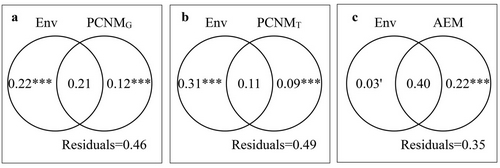
Newsroom
Flow Directionality: Most Decisive Factor in Structuring Diatom Metacommunity of High Mountain Streams
The mountains of Southwest China have typical landforms, which breed rich resources and unique patterns of biodiversity, and listed as one of the 34 biodiversity hotspots in the world by Conservation International (CI). It is of great importance to conduct research and conservation of biodiversity in this area that exploring the community structuring and maintaining mechanism of high mountains. However, it has currently been poorly understood for streams.
A research team led by Prof. CAI Qinghua from Institute for Hydrobiology, Chinese Academy of Sciences (IHB) has investigated benthic diatoms in high mountain streams (elevation ranges from 1600 to 2900 m a.s.l.) in Southwestern China, and applied spatial models to model all pathways of diatom dispersal, including geographical (overland), topographical (across mountain barriers) and network (along flow direction) pathways. Relative contributions of environmental vs. three dispersal processes were assessed to explore the mechanism of community assembly from a metacommunity perspective.
The results indicated that the directional processes overrided any other effects in structuring and maintaining the communities, not only shaped directional environmental gradients, but also facilitated dispersal of benthic organisms along stream channels. In addition, dispersal limitation was shown among streams by mountain barriers even at a small scale. For biodiversity conservation, maintaining the instream environmental flow and keeping various habitats among streams are of vital importance in high mountain streams.
This study was financially supported by Major Science and Technology Program for Water Pollution Control and Treatment (2012ZX07501002-007) and Collaborative Innovation Center for the Biodiversity in the Three Parallel Rivers of China. The findings have been published in Scientific Reports on April 19th, 2016 with the title of "Flow directionality, mountainbarriers and functional traitsdetermine diatom metacommunitystructuring of high mountainstreams".
 |
| Figure 1 Hypothetical pathways of organisms’ dispersal among sites along or among streams in high mountains. (a) Geographical pathway (overland dispersal); (b) topographical pathway (across mountain barriers); (c) network pathway (along flow direction). The locations of communities are shown as green dots, streams are depicted by blue lines and red lines represent dispersal pathways between locations. (Image by IHB) |
 |
|
Figure 2 Venn-diagrams showing the results of variation partitioning performed on (a) Environmental model (Env) and Geographical model (PCNMG), (b) Environmental model (Env) and Topographic model (PCNMT), and (c) Environmental model (Env) andDirectional spatial model (AEM)for benthic diatom metacommuntiy in the study area. Variation explained uniquely and jointly, and the unexplained fractions were shown as the number in each part of the figures (total variation= 1). The significance of each testable fraction was expressed as?(P<0.1), *(P<0.05), ** (P<0.01), *** (P<0.001) (Image by IHB) |